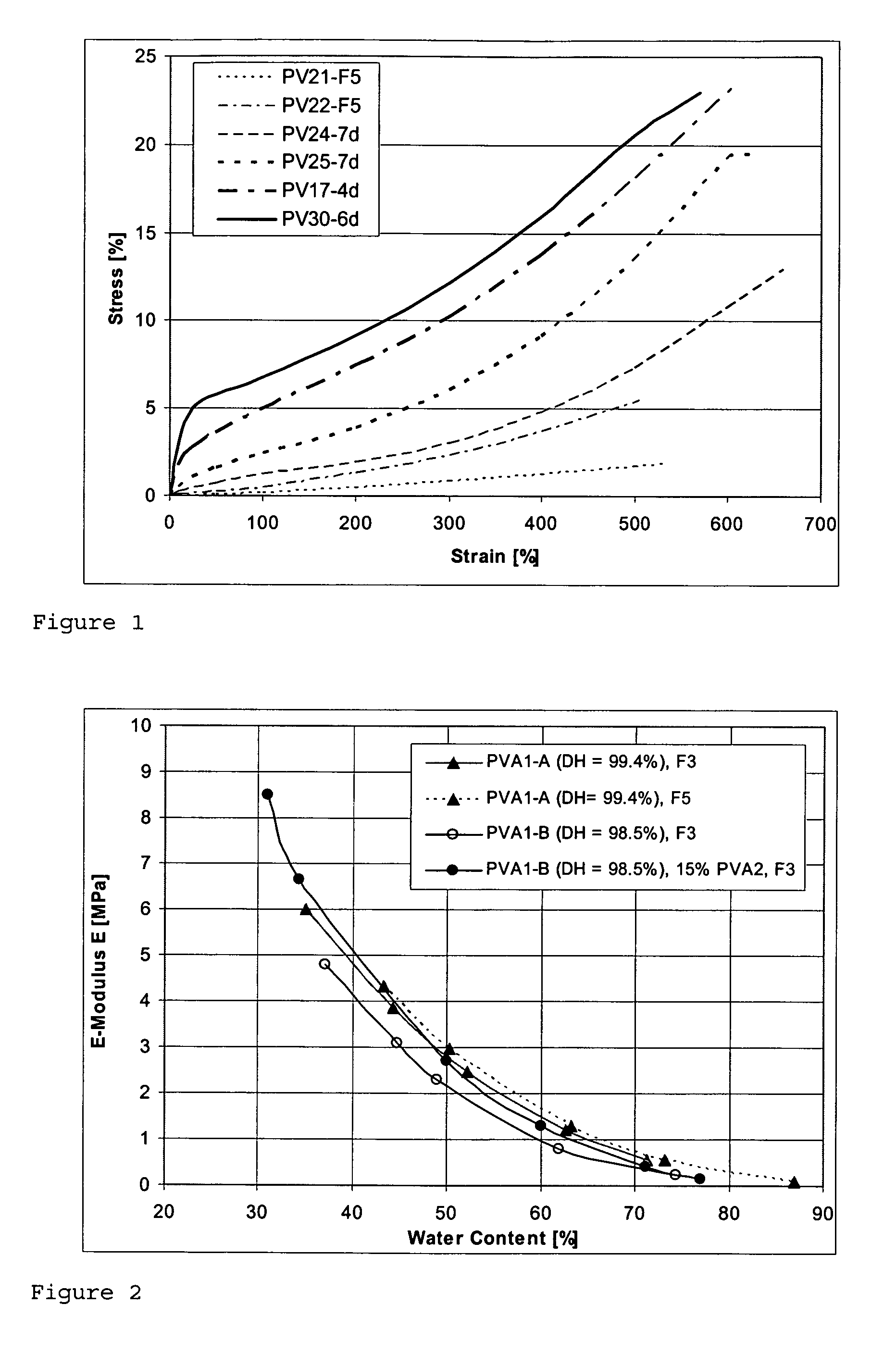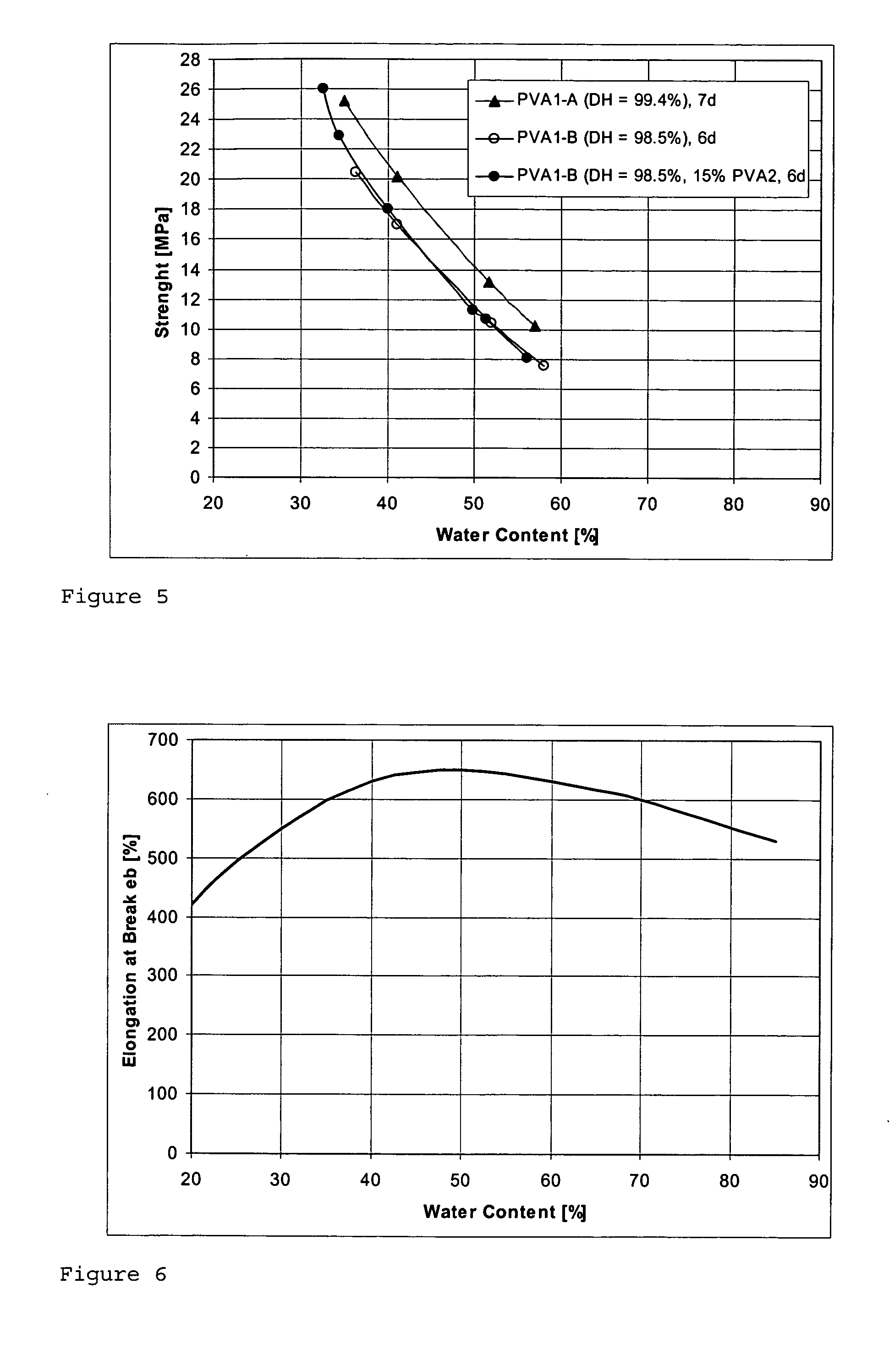Polyvinyl alcohol gels
a polyvinyl alcohol gel and polyvinyl alcohol technology, applied in the field of polyvinyl alcohol gels, can solve the problems of difficult preparation of solutions, inability to maintain its shape outside water, and inability to optimise cp and dp independently of each other, and achieve the effects of improving the mechanical properties of the resulting pvag, reducing the occurrence of cp and dp, and improving the effect of elasticity
- Summary
- Abstract
- Description
- Claims
- Application Information
AI Technical Summary
Benefits of technology
Problems solved by technology
Method used
Image
Examples
example 1
[0055]FIG. 1 shows the stress-strain curves of various PVAGs. The composition of the PVAG and the preparation parameters can be seen from Table 1:
TABLE 1No.PVA1PVA2PVa2 [%]W [%]TreatmentPV21-F5DP = 4500,0875 cyclesDH = 99.4mole %PV22-F5DP = 4500,0735 cyclesDH = 99.4mole %PV24-7dDP = 4500,0527 days atDH = 99.4RTmole %PV25-7dDP = 4500,0417 days atDH = 99.4RTmole %PV17-4dDP = 4500,DP = 360,2033TemperedDH = 98.5DH = 98.5at 70° C.,mole %mole %then 4days atRTPV30-6dDP = 4500,DP = 360,4028TemperedDH = 98.5DH = 98.5at 110° C.,mole %mole %then 6days atRT
[0056] The PVAG PV21-F5 was obtained in accordance with the prior art with Cp=13% or a water content W=87% from a solution which had undergone 5 freeze / thaw cycles. The relevant stress-strain curve represents the mechanical properties which can be obtained in accordance with the prior art starting from a solution and subsequent freeze / thaw cycles. In this case, the stress increases continuously in the tensile test, with the slope of the cur...
example 2
[0061]FIG. 2 shows the profile of the modulus of elasticity of PVAG after 3 (F3) and 5 (F5) freeze / thaw cycles as a function of the water content W of the PVA-water mixture for various PVA and PVA mixtures. With the exception of PVAG with 87% water content which was prepared starting from a solution, all the other PVAGs were prepared using thermoplastic methods. Solutions based on the polyvinyl alcohols PVA1-A and PVA1-B which both have a degree of polymerisation DP of around 4500, reach the limiting viscosity for solutions of 10,000 cPa at 80° C. at approximately Cp 15%, i.e. with an 85% water content so that the preparation of solutions and pouring is no longer possible at lower water contents. The range of water contents W<85% where a massive increase in the modulus of elasticity and therefore the mechanical properties can be obtained is only accessible by the PVAG according to the invention. It is clearly manifest that the water content is the dominant parameter relating to the ...
example 3
[0066] In FIG. 4 the moduli of elasticity of PVAG obtained using a thermoplastic method are plotted as a function of the water content W. The PVAG was stored after shaping at RT for 7 or 6 days, i.e., the PVAG was obtained without using freeze / thaw cycles. It is clear that especially in the range W<60% PVAGs can be obtained without using freeze / thaw cycles by simple storage at RT. In this case, the PVAGs based on PVA1-A with the higher degree of hydrolysis have the highest moduli of elasticity. The PVAG based on PVA1-B containing a 15% fraction of short-chain PVA shows slightly higher moduli of elasticity in the range 50%
PUM
| Property | Measurement | Unit |
|---|---|---|
| temperature | aaaaa | aaaaa |
| temperature | aaaaa | aaaaa |
| degree of polymerisation | aaaaa | aaaaa |
Abstract
Description
Claims
Application Information
 Login to View More
Login to View More - R&D
- Intellectual Property
- Life Sciences
- Materials
- Tech Scout
- Unparalleled Data Quality
- Higher Quality Content
- 60% Fewer Hallucinations
Browse by: Latest US Patents, China's latest patents, Technical Efficacy Thesaurus, Application Domain, Technology Topic, Popular Technical Reports.
© 2025 PatSnap. All rights reserved.Legal|Privacy policy|Modern Slavery Act Transparency Statement|Sitemap|About US| Contact US: help@patsnap.com



